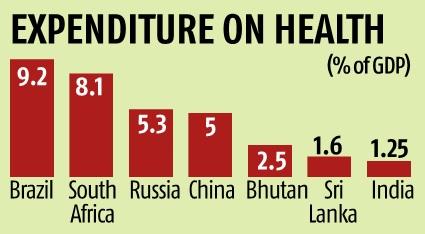ForumIAS announcing GS Foundation Program for UPSC CSE 2025-26 from 19 April. Click Here for more information.
ForumIAS Answer Writing Focus Group (AWFG) for Mains 2024 commencing from 24th June 2024. The Entrance Test for the program will be held on 28th April 2024 at 9 AM. To know more about the program visit: https://forumias.com/blog/awfg2024
What is the news?
Recently, Oxfam India released “Inequality Report 2021: India’s Unequal Healthcare Story”. Oxfam India’s inequality report draws attention to the county’s unequal healthcare story hit further by Covid-19.
The report shows that the constant underfunding of the public healthcare system in the last decade have worsened health infrastructure.
Key findings of the report
- The report says that the absence of universal health coverage has starkly and disproportionately affected marginalised groups at a time when socio-economic inequalities in India are growing because of the Covid-19 pandemic. When it comes to healthcare,
- People in the general category are better off than Scheduled Castes (SC) and Scheduled Tribes (ST) households;
- The rich do better than the poor; men are better off than women, and
- The urban population fares better than the rural.
- The disastrous second wave of the Covid-19 pandemic further exposed the weakness of India’s public healthcare system. Such as,
- Currently, India ranks 155 out of 167 countries on bed availability and has five beds and 8.6 doctors per 10,000 of its population.
- Rural India, which makes for 70 per cent of the population, has barely 40 per cent of the beds.
- The number of hospital beds per thousand population in India (at 0.5) is lower than some of the lesser developed countries such as Bangladesh (0.87), Kenya (1.4), and Chile (2.1).
- Persistent underfunding of (the) public health system, especially primary health care and inadequate health infrastructure in India remain to be addressed.
- Over the years, a better health system has, for instance, helped increase life expectancy, but outcomes have varied across gender, caste and income levels. For instance,
- The rich, on average, live seven-and-a-half years more than the poor
- A woman from the general category lives, on an average, 15 years longer than a Dalit woman
- Oxfam India findings show that higher public health allocations have a positive effect on health outcomes in a pandemic. For instance, States such as Odisha and Goa, with higher expenditure on health, also had higher recovery rate from Covid-19.
- In Oxfam’s “Commitment to Reducing Inequality Report 2020”, India ranks 154th in health spending, fifth from the bottom.
- In the 2021-22 Union Budget, a year following a pandemic, the Ministry of Health and Family Welfare (MoHFW) budget was allocated with a 9.8 percent decline from the Revised Estimates of 2020-21.
Recommendations of the report
The report recommends the implementation of universal health coverage (UHC) supported by a strong public health sector.






